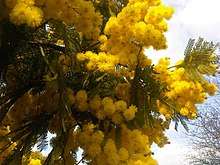Mimosa
Mimosa is a genus of about 400 species of herbs and shrubs, in the mimosoid clade of the legume family Fabaceae. The generic name is derived from the Greek word μῖμος (mimos), an "actor" or "mime", and the feminine suffix -osa, "resembling", suggesting its 'sensitive leaves' which seem to 'mimic conscious life'.[1][2]
| Mimosa | |
|---|---|
 | |
| Mimosa pudica flower heads | |
| Scientific classification | |
| Kingdom: | Plantae |
| Clade: | Tracheophytes |
| Clade: | Angiosperms |
| Clade: | Eudicots |
| Clade: | Rosids |
| Order: | Fabales |
| Family: | Fabaceae |
| Clade: | Mimosoideae |
| Genus: | Mimosa L. |
| Species | |
|
About 400 species, see text | |
| Synonyms | |
| |
Two species in the genus are especially notable. One is Mimosa pudica, which folds its leaves when touched or exposed to heat. It is native to southern Central and South America but is widely cultivated elsewhere for its curiosity value, both as a houseplant in temperate areas, and outdoors in the tropics. Outdoor cultivation has led to weedy invasion in some areas, notably Hawaii. The other is Mimosa tenuiflora, which is best known for its use in shamanic ayahuasca brews due to the psychedelic drug dimethyltryptamine found in its root bark.
Taxonomy
The taxonomy of the genus Mimosa has had a tortuous history, having gone through periods of splitting and lumping, ultimately accumulating over 3,000 names, many of which have either been synonymized under other species or transferred to other genera. In part due to these changing circumscriptions, the name "Mimosa" has also been applied to several other related species with similar pinnate or bipinnate leaves, but are now classified in other genera. The most common examples of this are Albizia julibrissin (Persian silk tree) and Acacia dealbata (wattle).
Description
Members of this genus are among the few plants capable of rapid movement; examples outside of Mimosa include the telegraph plant, Aldrovanda, some species of Drosera and the Venus flytrap. The leaves of the Mimosa pudica close quickly when touched. Some mimosas raise their leaves in the day and lower them at night, and experiments done by Jean-Jacques d'Ortous de Mairan on mimosas in 1729 provided the first evidence of biological clocks.[3]
Mimosa can be distinguished from the large related genera, Acacia and Albizia, since its flowers have ten or fewer stamens. Botanically, what appears to be a single globular flower is actually a cluster of many individual ones. Mimosa contains some level of heptanoic acid.
Species
There are about 400 species including:
- Mimosa aculeaticarpa Ortega
- Mimosa andina Benth.
- Mimosa arenosa (Willd.) Poir.
- Mimosa asperata L.
- Mimosa borealis Gray
- Mimosa caesalpiniaefolia Benth.
- Mimosa casta L.
- Mimosa cupica Gray
- Mimosa ceratonia L.
- Mimosa diplotricha C.Wright ex Sauvalle
- Mimosa disperma Barneby
- Mimosa distachya Cav.
- Mimosa dysocarpa Benth.
- Mimosa emoryana Benth.
- Mimosa grahamii Gray
- Mimosa hamata Willd.
- Mimosa hystricina (Small ex Britt. et Rose) B.L.Turner
- Mimosa invisa Martius ex Colla
- Mimosa latidens (Small) B.L. Turner
- Mimosa laxiflora Benth.
- Mimosa loxensis Barneby
- Mimosa malacophylla Gray
- Mimosa microphylla Dry.
- Mimosa nothacacia Barneby
- Mimosa nuttallii (DC.) B.L. Turner
- Mimosa ophthalmocentra Mart. ex Benth. 1865
- Mimosa pellita Kunth ex Willd.
- Mimosa pigra L.
- Mimosa polycarpa Kunth
- Mimosa pudica L.
- Mimosa quadrivalvis L.
- Mimosa quadrivalvis var. hystricina (Small) Barneby
- Mimosa quadrivalvis var. quadrivalvis L.
- Mimosa roemeriana Scheele
- Mimosa rubicaulis Lam.
- Mimosa rupertiana B.L. Turner
- Mimosa scabrella Benth.
- Mimosa schomburgkii Benth.
- Mimosa somnians Humb. & Bonpl. ex Willd.
- Mimosa strigillosa Torr. et Gray
- Mimosa tenuiflora (Willd.) Poir. (= Mimosa hostilis)
- Mimosa texana (Gray) Small
- Mimosa townsendii Barneby
- Mimosa turneri Barneby
- Mimosa verrucosa Benth.
Uses
The bark, leaves and flowers have been used for centuries in traditional Chinese medicine.[4] The bark is still known as 'Collective Happiness Bark' and is used for cleansing the body's energetic pathways (heart and liver meridians), allegedly providing a spiritual boost for those who take it.[5]
The ancient Mayans also used it regularly to treat injuries and burns.
Despite this, modern research remains surprisingly insignificant, but the powdered bark is commonly used by homeopaths as an anti-inflammatory, anti-septic, cough/cold relief and painkiller.
References
| Wikimedia Commons has media related to Mimosa. |
| Wikispecies has information related to Mimosa |
- Gledhill, D. (2008). The Names of Plants (4 ed.). Cambridge University Press. p. 356. ISBN 978-0-521-86645-3.
- Austin, Daniel F. (2004). Florida ethnobotany Fairchild Tropical Garden, Coral Gables, Florida, Arizona-Sonora Desert Museum, Tucson, Arizona: with more than 500 species illustrated by Penelope N. Honychurch ... [et al.] Boca Raton, Florida: CRC Press. p. 58. ISBN 9780203491881.
- Neuroscience; Bear, Connors, Paradiso
- "Mimosa- Fragrant Winter Blooms".
- Tierra, Michael (2008-05-29). "Albizia: The Tree of Happiness". East West Herb Courses. Retrieved 2020-01-09.
- Barneby, R.C. 1992. Sensitivae Censitae: A description of the genus Mimosa Linnaeus (Mimosaceae) in the New World. Memoirs of the New York Botanical Garden, vol. 65.


